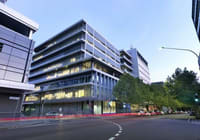
Plenty of heave-ho behind building new Fremantle offices for shipping line MSC
If these historical walls could talk, they might reveal many of Australia’s deepest secrets.
Once used for secretive military operations, the grand building at 11 Cliff Street, Fremantle, has been restored meticulously over four years to become the new Australia-New Zealand headquarters of the Mediterranean Shipping Company.
During its 114-year history, the heritage-listed building in Freo’s west end has housed businesses, news bureaus and, in World War II, Royal Australian Navy intelligence. It’s also close to one of the WA’s most significant historical sites, The Roundhouse.
Watch time-lapse video of the restoration.
MSC Australia and New Zealand managing director Kevin Clarke, who leads the company’s Oceania operations with Captain Michele Bordiga, says the company had been excited to restore a building which had a significant role in the history of the Fremantle port.
 The site of the annexe in December 2014. Photo: Supplied
The site of the annexe in December 2014. Photo: Supplied
 The design lines of the glass-fronted annexe echo the surrounding historical buildings. Photo: Bob Sommerville
The design lines of the glass-fronted annexe echo the surrounding historical buildings. Photo: Bob Sommerville
The shipping line, one of the world’s biggest with 480 offices in 150 countries, has had a presence in Australia for 27 years, starting as a small office in Sydney in 1989.
MSC has called WA home for its Australia and New Zealand operations for 16 years because the time zone enables staff to communicate effectively with MSC’s international headquarters in Geneva, Switzerland.
 The new boardroom at MSC’s 11 Cliff Street offices even has a porthole. Photo: Ed Janes
The new boardroom at MSC’s 11 Cliff Street offices even has a porthole. Photo: Ed Janes
 Inside the tower at the front and centre of the MSC building in Fremantle. Photo: Ed Janes
Inside the tower at the front and centre of the MSC building in Fremantle. Photo: Ed Janes
“The building has had a colourful and interesting history – always at the heart of the Fremantle business community,” Mr Clarke says.
MSC worked with Murray Slavin, of Slavin Architects, on the $14.5 million project to restore the historical building and add a new 1082-square-metre adjoining annexe to accommodate its 128 staff and even more in the future.
The 12-metre-wide glass-fronted annexe facing Cliff Street has a “rib” design that references arches of the existing heritage buildings on either side.
 The new Fremantle offices of the Mediterranean Shipping Company. Photo: Bob Sommerville
The new Fremantle offices of the Mediterranean Shipping Company. Photo: Bob Sommerville
The building was designed by WA architect and First World War general Sir Joseph J. Talbot Hobbs, who was also behind the Savoy Hotel in the Hay Street Mall and the men-only Weld Club.
The biggest change in the Cliff Street site – removing the cement render and restoring the brickwork – has also been the most painstaking.
In the mid-1960s, the render was applied in a bid to protect the the old masonry from water and salt. However, it had the reverse effect, trapping water against the building.
 A maritime theme in the annexe, with a compass design on the floor. Photo: Bob Sommerville
A maritime theme in the annexe, with a compass design on the floor. Photo: Bob Sommerville
It took a year for Adelaide-based company Heritage Stone Restorations, under the direction of Slavin Architects and working with the State Heritage Office and the City of Fremantle, to repair the masonry, remove the salt from the brick substrate, replace the old lime mortar and apply tuck-pointing to match the original colour.
Hand-tools were used to minimise damage and natural earthen pigments were used to colour-match the early mortar.
 Looking upwards under the grand staircase. Photo: Ed Janes
Looking upwards under the grand staircase. Photo: Ed Janes
Marc Beattie, senior heritage planner at town planning and urban design company TPG, gave specialised brickwork conservation advice.
MSC’s move marks a full-circle return to the building’s business origins – it was built in 1902 as the home of another export and import company – Dalgety & Co. The company was one of the first established in the area after Fremantle Harbour opened to shipping in 1897.
“This building cost £30,000 to build and at the time was the largest contract for a private building in the state,” Richard Offen, Heritage Perth executive director, told ABC Radio earlier this year.
In 1927, agricultural supply company Elder Smith & Co bought the building and it was renamed Elders House.
During the 25-year occupancy of another shipping line, the Norwegian and Swedish-owned Wallenius Wilhelmsen, the building was known as Wilhelmsen House.
 The lift to the “sky deck” at the new MSC offices in Fremantle has the appearance of a shipping container on its end. Photo: Ed Janes
The lift to the “sky deck” at the new MSC offices in Fremantle has the appearance of a shipping container on its end. Photo: Ed Janes
 The sky deck of the new MSC offices looking towards the port of Fremantle. Photo: Ed Janes
The sky deck of the new MSC offices looking towards the port of Fremantle. Photo: Ed Janes
It has also been known as Barwil House and has been the premises of small businesses and the Fremantle TAFE.
Mr Clarke says the investment demonstrates the company’s commitment to the region. The Fremantle location provided a strategic gateway to Asia and MSC’s wider global network and the company’s cargo import and export business had enjoyed strong growth during the past decade.
“MSC is investing in the Australian and New Zealand market and we are here for the long haul,” he says.
- View property for sale and for lease in Fremantle at Commercial Real Estate










